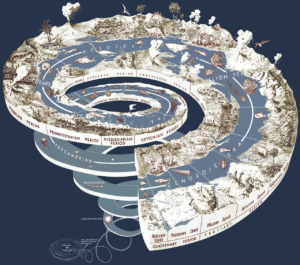| (18.16.12) 11.722 Northlight 85 (9.03 |

Current Eon began: ~250 million years ago
Length of time: 250,000,000 (250 million) years
Rationale for time length:
The time length of 250 million years ago is related to some significant developments in Earth history. Having a unit of time this length enables us to put in perspective other aspects of Earth’s history, and to have a more accurate understanding of when certain events happened during Earth’s history.
The three events related to Earth history are as follows:
The length of an Eon on this calendar is the upper estimate of what is known as a Galactic Year. That is about the length of time that our Sun takes to orbit around the Milky Way galaxy.
Dinosaurs first appeared on Earth between 243 million and 231 years ago.
The Cambrian Explosion, in which most of the major animal phyla that exist today first appeared was a little more than two Eons ago. Prior to the Cambrian Explosion, most life on Earth consisted of microorganisms and the continents were lifeless deserts.
The Earth is approximately 4.54 billion years old, give or take 50 million years. If we divided 4.54 billion by 250 million, we could then say that the earth is 18.16 eons old. As such, we say that we are in Eon 18. It then follows that the dinosaurs evolved near the beginning of Eon 17. The Cambrian explosion came into being around the end of Eon 15. Life first evolved somewhere between Eon 0 and 3, but even so, the continents on the earth were barren lands devoid of life until the Cambrian Explosion began. Until that time, most life on Earth consisted of microorganisms.
You can see the enormous difference between the beginning of Eon 16 and Eon 17 in the two videos below.
And here’s some information about that Galactic Year.
So you can see how the Eon is helpful in understanding Earth history. It is revealing that the time period between the present and the advent of the dinosaurs constitutes less than one-eighteenth of the entire history of Earth. See how much better we understand Earth history already?
Relationship between the Calendar Eon and the Geological Eon.
The Geologic Time Scale (GTS), like the Earth Epic Calendar, has the Eon as its largest unit of measure. But the GTS is based on stratigraphy and significant moments in Earth history, as opposed to precise lengths of time. The “Geologic Eon” ranges in length from 500 million to 2 billion years. Examples of the Geologic Eon are the Hadean Eon between 4.6 and 4.0 billion years ago and the Proterozoic Eon from 2.5 billion to 541 million years ago, and both represent very distiinctive stages in Earth’s development. Whereas the “Calendar Eon” is set at fixed period of time of 250 million years.
It’s important to note that the estimated age of the Earth allows for a variance of 50 million years prior to or later than 4.54 billion years ago (meaning 4.59 or 4.49 billion years ago. We cannot, at this time, establish the exact day or year or even millennium the Earth was created. It would probably be difficult to even set criteria describing when Earth was, essentially, “created” as it was a process of materials gathering together out of what was largely dust whirling around the new Sun. I will go more into the impacts of this discrepancy when talking about the next highest time scale, Genesis.
—> (next stop on the Calendar Tour, Genesis)
return to The Epic Time Scales page